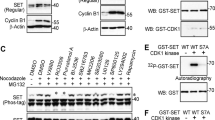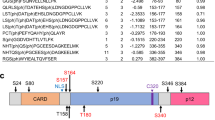Abstract
BCL2 family members are subject to regulation at multiple levels, providing checks on their ability to contribute to tumorigenesis. However, findings on post-translational BCL2 phosphorylation in different systems have been difficult to integrate. Another antiapoptotic family member, MCL1, exhibits a difference in electrophoretic mobility upon phosphorylation induced by an activator of PKC (12-O-tetradecanoylphorbol 13-acetate; TPA) versus agents that act on microtubules or protein phosphatases 1/2A. A multiple pathway model is now presented, which demonstrates that MCL1 can undergo distinct phosphorylation events – mediated through separate signaling processes and involving different target sites – in cells that remain viable in the presence of TPA versus cells destined to die upon exposure to taxol or okadaic acid. Specifically, TPA induces phosphorylation at a conserved extracellular signal-regulated kinase (ERK) site in the PEST region (Thr 163) and slows turnover of the normally rapidly degraded MCL1 protein; however, okadaic acid and taxol induce ERK-independent MCL1 phosphorylation at additional discrete sites. These findings add a new dimension to our understanding of the complex regulation of antiapoptotic BCL2 family members by demonstrating that, in addition to transcriptional and post-transcriptional regulation, MCL1 is subject to multiple, separate, post-translational phosphorylation events, produced in living versus dying cells at ERK-inducible versus ERK-independent sites.
This is a preview of subscription content, access via your institution
Access options
Subscribe to this journal
Receive 50 print issues and online access
$259.00 per year
only $5.18 per issue
Buy this article
- Purchase on Springer Link
- Instant access to full article PDF
Prices may be subject to local taxes which are calculated during checkout








Similar content being viewed by others
References
Akgul C, Moulding DA, White MR and Edwards SW . (2000). FEBS Lett., 478, 72–76.
Basu A and Haldar S . (1998). Int. J. Oncol., 13, 659–664.
Basu A, You SA and Haldar S . (2000). Int. J. Oncol., 16, 497–500.
Bingle CD, Craig RW, Hanks BM, Eaton V, Zhou P and Whyte MKB . (2000). J. Biol. Chem., 275, 22136–22146.
Blagosklonny MV . (2001). Leukemia, 15, 869–874.
Blagosklonny MV, Giannakakou P, el-Deiry WS, Kingston DG, Higgs PI, Neckers L and Fojo T . (1997). Cancer Res., 57, 130–135.
Breitschopf K, Haendeler J, Malchow P, Zeiher AM and Dimmeler S . (2000). Mol. Cell. Biol., 20, 1886–1896.
Chen MC, Gong HY, Cheng CY, Wang JP, Hong JR and Wu JL . (2000). BBRC, 279, 725–731.
Clurman BE, Sheaff RJ, Thress K, Groudine M and Roberts JM . (1996). Genes Dev., 10, 1979–1990.
Craig RW . (2002). Leukemia, 16, 444–454.
Cuconati A, Mukherjee C, Perez D and White E . (2003). Genes Dev., 23, 2922–2932.
Deng X, Gao F, Flagg T and May WS . (2004). Proc. Natl. Acad. Sci. USA, 101, 153–158.
Deng X, Ruvolo P, Carr B and May WS . (2000). Proc. Natl. Acad. Sci. USA, 97, 1578–1583.
Deng X, Xiao L, Lang W, Gao F, Ruvolo P and May WS . (2001). J. Biol. Chem., 276, 23681–23688.
Dimmeler S, Breitschopf K, Haendeler J and Zeiher AM . (1999). J. Exp. Med., 189, 1815–1822.
Domina A, Smith JH and Craig RW . (2000). J. Biol. Chem., 275, 21688–21694.
Du L, Lyle CS, Hall-Obey TB, Gaarde WA, Muir JA, Bennett BL and Chambers TC . (2004). J. Biol. Chem., 279, 11957–11966.
Fan M, Goodwin M, Vu T, Brantley-Finley C, Gaarde WA and Chambers TC . (2000). J. Biol. Chem., 39, 29980–29985.
Furukawa Y, Iwase S, Kikuchi J, Terui Y, Nakamura M, Yamada H, Kano Y and Matsuda M . (2000). J. Biol. Chem., 275, 21661–21667.
Gregory MA and Hann SR . (2000). Mol. Cell. Biol., 20, 2423–2435.
Gregory MA, Qi Y and Hann SR . (2003). J. Biol. Chem., 278, 51606–51612.
Haldar S, Basu A and Croce CM . (1998). Cancer Res., 58, 1609–1615.
Harada H, Andersen JS, Mann M, Terada N and Korsmeyer SJ . (2001). Proc. Natl. Acad. Sci. USA, 98, 9666–9670.
Inoshita S, Takeda K, Hatai T, Terada Y, Sano M, Hata J, Umezawa A and Ichijo H . (2002). J. Biol. Chem., 277, 43730–43734.
Ito T, Deng X, Carr B and May WS . (1997). J. Biol. Chem., 272, 11671–11673.
Koepp DM, Schaefer LK, Ye X, Keyomarsi K, Chu C, Harper JW and Elledge SJ . (2001). Science, 294, 173–177.
Kozopas KM, Yang T, Buchan HL, Zhou P and Craig RW . (1993). Proc. Natl. Acad. Sci. USA, 90, 3516–3520.
Li X, Zhao X, Fang Y, Jiang X, Dong T, Fan C, Huang C-C and Kain SR . (1998). J. Biol. Chem., 273, 34970–34975.
Luciano F, Jacquel A, Colosetti P, Herrant M, Cagnol S, Pages G and Auberg P . (2003). Oncogene, 22, 6785–6793.
Lutterbach B and Hann SR . (1994). Mol. Cell. Biol., 14, 5510–5522.
Matsuoka K, Kiyokawa N, Taguchi T, Matsui J, Suzuki T, Mimori K, Nakajima H, Takenouchi H, Weiran T, Katagiri YU, Fujimoto J and May WS . (2002). Eur. J. Biochem., 269, 3511–3521.
Maundrell K, Antonsson B, Magnenat E, Camps M, Muda M, Chabert C, Gillieron C, Boschert U, Vial-Knecht E, Martinou JC and Arkinstall S . (1997). J. Biol. Chem., 272, 25238–25242.
May WS, Tyler PG, Ito T, Armstrong DK, Qatsha KA and Davidson NE . (1994). J. Biol. Chem., 269, 26865–26870.
Musti AM, Treier M and Bohmann D . (1997). Science, 275, 400–402.
Nijhawan D, Fang M, Traer E, Zhong Q, Gao W, Du F and Wang X . (2003). Genes Dev., 17, 1475–1486.
Okazaki K and Sagata N . (1995). EMBO J., 14, 5048–5049.
Opferman JT, Letai A, Beard C, Sorcinelli MD, Ong CC and Korsmeyer SJ . (2003). Nature, 426, 671–676.
Rechsteiner M . (1990). Sem. Cell Biol., 1, 433–440.
Reynolds JE, Li J, Craig RW and Eastman A . (1996). Exp. Cell Res., 225, 430–436.
Reynolds JE, Yang T, Qian L, Jenkinson JD, Zhou P, Eastman A and Craig RW . (1994). Cancer Res., 54, 6348–6352.
Riviere LR and Tempst P . (1996). Current Protocols in Protein Science, Vol. 2. Coligan JE, Dunn BM, Ploegh HL, Speicher DW and Wingfield PT (eds) John Wiley and Sons, Inc., New York, pp. 11.1.12.
Ruvolo PP, Deng X and May WS . (2001). Leukemia, 15, 515–522.
Scatena CD, Stewart ZA, Mays D, Tang LJ, Keefer CJ, Leach SD and Pietenpol JA . (1998). J. Biol. Chem., 273, 30777–30784.
Scheid MP, Schubert KM and Duronio V . (1999). J. Biol. Chem., 274, 31108–31113.
Sears R, Leone G, DeGregori J and Nevins JR . (1999). Mol. Cell, 3, 169–179.
Sears R, Nuckolls F, Haura E, Taya Y, Tamai Y and Nevins JR . (2000). Genes Dev., 14, 2501–2514.
Srivastava RK, Mi QS, Hardwick JM and Longo DL . (1999). Proc. Natl. Acad. Sci. USA, 96, 3775–3780.
Srivastava RK, Srivastava AR, Korsmeyer SJ, Nesterova M, Cho-Chung YS and Longo DL . (1998). Mol. Cell. Biol., 18, 3509–3517.
Steinmann KE, Belinsky GS, Lee D and Schlegel R . (1991). Proc. Natl. Acad. Sci. USA, 88, 6843–6847.
Thomas A, Giesler T and White E . (2000). Oncogene, 19, 5259–5269.
Townsend KJ, Trusty JL, Traupman MA, Eastman A and Craig RW . (1998). Oncogene, 17, 1223–1234.
Townsend KJ, Zhou P, Bieszczad CK, Qian L and Craig RW . (1999). J. Biol. Chem., 274, 1802–1813.
Tsujimoto Y and Croce CM . (1986). Proc. Natl. Acad. Sci. USA, 83, 5214–5218.
Vantieghem A, Xu Y, Assefa Z, Piette J, Vandenheede JR, Merlevede W, de Witte PAM and Agostinis P . (2002). J. Biol. Chem., 277, 37718–37731.
Vrana JA, Bieszczad CK, Cleaveland ES, Yan M, Park JP, Mohandas TK and Craig RW . (2002). Cancer Res., 62, 892–900.
Wang HG, Pathan N, Ethell IM, Krajewski S, Yamaguchi Y, Shibasaki F, McKeon F, Bobo T, Franke TF and Reed JC . (1999). Science, 284, 339–343.
Yamamoto K, Ichijo H and Korsmeyer SJ . (1999). Mol. Cell. Biol., 19, 8469–8478.
Yang T, Kozopas KM and Craig RW . (1995). J. Cell. Biol., 128, 1173–1184.
Yang T, Kozopas KM and Craig RW . (1996). J. Cell Physiol., 166, 523–536.
Zhou P, Qian L, Bieszczad CK, Noelle R, Binder M, Levy NB and Craig RW . (1998). Blood, 92, 3226–3239.
Zhou P, Qian L, Kozopas KM and Craig RW . (1997). Blood, 89, 630–643.
Zhou P, Xie H, Qian L, Chi-Yu GL, Gascoyne RD, Levy NB and Craig RW . (2001). Blood, 97, 3902–3909.
Acknowledgements
This work was supported by National Cancer Institute Grant R01-CA57359. We thank Ethan Kohn for a very incisive, helpful review of the paper.
Author information
Authors and Affiliations
Corresponding author
Rights and permissions
About this article
Cite this article
Domina, A., Vrana, J., Gregory, M. et al. MCL1 is phosphorylated in the PEST region and stabilized upon ERK activation in viable cells, and at additional sites with cytotoxic okadaic acid or taxol. Oncogene 23, 5301–5315 (2004). https://doi.org/10.1038/sj.onc.1207692
Received:
Revised:
Accepted:
Published:
Issue Date:
DOI: https://doi.org/10.1038/sj.onc.1207692
Keywords
This article is cited by
-
Proteomic investigation of neural stem cell to oligodendrocyte precursor cell differentiation reveals phosphorylation-dependent Dclk1 processing
Cellular and Molecular Life Sciences (2023)
-
Increased MCL-1 synthesis promotes irradiation-induced nasopharyngeal carcinoma radioresistance via regulation of the ROS/AKT loop
Cell Death & Disease (2022)
-
Inhibition of CPT1a as a prognostic marker can synergistically enhance the antileukemic activity of ABT199
Journal of Translational Medicine (2021)
-
The combination of CUDC-907 and gilteritinib shows promising in vitro and in vivo antileukemic activity against FLT3-ITD AML
Blood Cancer Journal (2021)
-
Bayesian multi-source regression and monocyte-associated gene expression predict BCL-2 inhibitor resistance in acute myeloid leukemia
npj Precision Oncology (2021)



